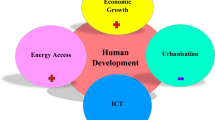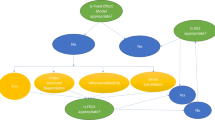Abstract
In this study, the impact of energy, agriculture, macroeconomic and human-induced indicators on environmental pollution from 1971 to 2011 is investigated using the statistically inspired modification of partial least squares (SIMPLS) regression model. There was evidence of a linear relationship between energy, agriculture, macroeconomic and human-induced indicators and carbon dioxide emissions. Evidence from the SIMPLS regression shows that a 1% increase in crop production index will reduce carbon dioxide emissions by 0.71%. Economic growth increased by 1% will reduce carbon dioxide emissions by 0.46%, which means that an increase in Ghana’s economic growth may lead to a reduction in environmental pollution. The increase in electricity production from hydroelectric sources by 1% will reduce carbon dioxide emissions by 0.30%; thus, increasing renewable energy sources in Ghana’s energy portfolio will help mitigate carbon dioxide emissions. Increasing enteric emissions by 1% will increase carbon dioxide emissions by 4.22%, and a 1% increase in the nitrogen content of manure management will increase carbon dioxide emissions by 6.69%. The SIMPLS regression forecasting exhibited a 5% MAPE from the prediction of carbon dioxide emissions.





Similar content being viewed by others
References
Acaravci A, Ozturk I (2010) On the relationship between energy consumption, CO 2 emissions and economic growth in Europe. Energy 35:5412–5420
Akon-Yamga G, Boadu P, Obiri BD, Amoako J, Mboob F (2011) Agricultural innovations for climate change adaptation and food security in Africa: the cases of Ghana and the Gambia. African Technology Policy Studies Network, Working paper series
Apergis N, Payne JE (2011) The renewable energy consumption–growth nexus in Central America. Appl Energy 88:343–347. doi:10.1016/j.apenergy.2010.07.013
Asumadu-Sarkodie S, Owusu P (2016a) A review of Ghana’s energy sector national energy statistics and policy framework. Cogent Eng 3:1155274. doi:10.1080/23311916.2016.1155274
Asumadu-Sarkodie S, Owusu PA (2016b) Carbon dioxide emissions, GDP, energy use and population growth: a multivariate and causality analysis for Ghana, 1971-2013. Environ Sci Pollut Res Int 23:13508–13520. doi:10.1007/s11356-016-6511-x
Asumadu-Sarkodie S, Owusu PA (2016c) The causal nexus between carbon dioxide emissions and agricultural ecosystem—an econometric approach Environ Sci and Pollut Res International doi:10.1007/s11356-016-7908-2
Asumadu-Sarkodie S, Owusu PA (2016d) Energy use, carbon dioxide emissions, GDP, industrialization, financial development, and population, a causal nexus in Sri Lanka: with a subsequent prediction of energy use using neural network. Energy Sources Part B Econ Plan Policy 11:889–899. doi:10.1080/15567249.2016.1217285
Asumadu-Sarkodie S, Owusu PA (2016e) A multivariate analysis of carbon dioxide emissions, electricity consumption, economic growth, financial development, industrialization and urbanization in Senegal. Energy Sources Part B Econ Plan Policy. doi:10.1080/15567249.2016.1227886
Asumadu-Sarkodie S, Owusu PA (2016f) Multivariate co-integration analysis of the Kaya factors in Ghana. Environ Sci Pollut Res Int 23:9934–9943. doi:10.1007/s11356-016-6245-9
Asumadu-Sarkodie S, Owusu PA (2016g) Recent evidence of the relationship between carbon dioxide emissions, energy use, GDP and population in Ghana: a linear regression approach. Energy Sources Part B Econ Plan Policy. doi:10.1080/15567249.2016.1208304
Asumadu-Sarkodie S, Owusu PA (2016h) The relationship between carbon dioxide and agriculture in Ghana: a comparison of VECM and ARDL model. Environ Sci Pollut Res Int 23:10968–10982. doi:10.1007/s11356-016-6252-x
Ben Abdallah K, Belloumi M, De Wolf D (2013) Indicators for sustainable energy development: a multivariate cointegration and causality analysis from Tunisian road transport sector. Renew Sust Energ Rev 25:34–43. doi:10.1016/j.rser.2013.03.066
Boulesteix A-L, Strimmer K (2007) Partial least squares: a versatile tool for the analysis of high-dimensional genomic data. Brief Bioinform 8:32–44
Cawley GC, Talbot NL (2004) Fast exact leave-one-out cross-validation of sparse least-squares support vector machines. Neural Netw 17:1467–1475
Ceglar A, Toreti A, Lecerf R, Van der Velde M, Dentener F (2016) Impact of meteorological drivers on regional inter-annual crop yield variability in France. Agric For Meteorol 216:58–67
Cerdeira Bento JP, Moutinho V (2016) CO2 emissions, non-renewable and renewable electricity production, economic growth, and international trade in Italy. Renew Sust Energ Rev 55:142–155. doi:10.1016/j.rser.2015.10.151
De Jong S (1993) SIMPLS: an alternative approach to partial least squares regression. Chemom Intell Lab Syst 18:251–263
Engle RF, Granger CW (1987) Co-integration and error correction: representation, estimation, and testing. Econometrica 55:251–276
EPA (2016) Methane emissions. https://www3.epa.gov/climatechange/ghgemissions/gases/ch4.html. Accessed July 7th, 2016
Eriksson L, Johansson E, Kettaneh-Wold N, Wold S (2001) Multi-and megavariate data analysis: principles and applications. Umetrics
FAO (2015) FAO statistical yearbooks—world food and agriculture. http://faostat3.fao. org/home/E. Accessed 24 Oct 2015
FAO (2016) Introduction & status of the forestry sector in Ghana. http://www.fao.org/docrep/003/ab567e/AB567E02.htm. Accessed 16 Jul 2016
Gosselin R, Rodrigue D, Duchesne C (2010) A bootstrap-VIP approach for selecting wavelength intervals in spectral imaging applications. Chemom Intell Lab Syst 100:12–21
Graham MH (2003) Confronting multicollinearity in ecological multiple regression. Ecology 84:2809–2815
Griffith DA, Harvey MG (2001) A resource perspective of global dynamic capabilities. J Int Bus Stud 32:597–606
Gul S, Zou X, Hassan CH, Azam M, Zaman K (2015) Causal nexus between energy consumption and carbon dioxide emission for Malaysia using maximum entropy bootstrap approach. Environ Sci Pollut Res 24:1–13
Huang B-N, Hwang MJ, Yang CW (2008) Causal relationship between energy consumption and GDP growth revisited: a dynamic panel data approach. Ecol Econ 67:41–54. doi:10.1016/j.ecolecon.2007.11.006
IPCC (2015) Working Group III: mitigation. http://www.ipcc.ch/ipccreports/tar/wg3/index.php?idp=90. Accessed 25 September, 2015
Jammazi R, Aloui C (2015) On the interplay between energy consumption, economic growth and CO2 emission nexus in the GCC countries: a comparative analysis through wavelet approaches. Renew Sust Energ Rev 51:1737–1751. doi:10.1016/j.rser.2015.07.073
Johansen S (1995) Likelihood-based inference in cointegrated vector autoregressive models. Oxford University Press, Oxford
Lozano S, Gutiérrez E (2008) Non-parametric frontier approach to modelling the relationships among population, GDP, energy consumption and CO2 emissions. Ecol Econ 66:687–699. doi:10.1016/j.ecolecon.2007.11.003
Mansfield ER, Helms BP (1982) Detecting multicollinearity. Am Stat 36:158–160
Mehmood T, Liland KH, Snipen L, Sæbø S (2012) A review of variable selection methods in partial least squares regression. Chemom Intell Lab Syst 118:62–69
Mohiuddin O, Asumadu-Sarkodie S, Obaidullah M (2016) The relationship between carbon dioxide emissions, energy consumption, and GDP: a recent evidence from Pakistan. Cogent Eng 3:1210491. doi:10.1080/23311916.2016.1210491
ND-GAIN (2014) Ghana. http://index.gain.org/country/ghana. Accessed 16 Jul 2016
O’brien RM (2007) A caution regarding rules of thumb for variance inflation factors. Qual Quant 41:673–690
Owusu P, Asumadu-Sarkodie S (2016a) A review of renewable energy sources, sustainability issues and climate change. Mitigation Cogent Eng 3:1167990. doi:10.1080/23311916.2016.1167990
Owusu PA, Asumadu-Sarkodie S (2016b) Is there a causal effect between agricultural production and carbon dioxide emissions in Ghana? Environ Eng Res. doi:10.4491/eer.2016.092
Ozturk I, Acaravci A (2010) The causal relationship between energy consumption and GDP in Albania, Bulgaria, Hungary and Romania: evidence from ARDL bound testing approach. Appl Energy 87:1938–1943
Ozturk I, Acaravci A (2011) Electricity consumption and real GDP causality nexus: evidence from ARDL bounds testing approach for 11 MENA countries. Appl Energy 88:2885–2892
Qureshi MI, Rasli AM, Zaman K (2016) Energy crisis, greenhouse gas emissions and sectoral growth reforms: repairing the fabricated mosaic. J Clean Prod 112:3657–3666. doi:10.1016/j.jclepro.2015.08.017
Rafindadi AA, Ozturk I (2015) Natural gas consumption and economic growth nexus: is the 10th Malaysian plan attainable within the limits of its resource? Renew Sust Energ Rev 49:1221–1232. doi:10.1016/j.rser.2015.05.007
Remuzgo L, Sarabia JM (2015) International inequality in CO2 emissions: a new factorial decomposition based on Kaya factors. Environ Sci Pol 54:15–24. doi:10.1016/j.envsci.2015.05.020
Salahuddin M, Gow J, Ozturk I (2015) Is the long-run relationship between economic growth, electricity consumption, carbon dioxide emissions and financial development in gulf cooperation council countries robust? Renew Sust Energ Rev 51:317–326. doi:10.1016/j.rser.2015.06.005
Seker F, Ertugrul HM, Cetin M (2015) The impact of foreign direct investment on environmental quality: a bounds testing and causality analysis for Turkey. Renew Sust Energ Rev 52:347–356. doi:10.1016/j.rser.2015.07.118
Shahbaz M, Lean HH, Shabbir MS (2012) Environmental Kuznets curve hypothesis in Pakistan: cointegration and granger causality. Renew Sust Energ Rev 16:2947–2953. doi:10.1016/j.rser.2012.02.015
Shahbaz M, Khraief N, Jemaa MMB (2015) On the causal nexus of road transport CO2 emissions and macroeconomic variables in Tunisia: evidence from combined cointegration tests. Renew Sust Energ Rev 51:89–100. doi:10.1016/j.rser.2015.06.014
Soytas U, Sari R (2009) Energy consumption, economic growth, and carbon emissions: challenges faced by an EU candidate member. Ecol Econ 68:1667–1675. doi:10.1016/j.ecolecon.2007.06.014
Tiwari AK, Shahbaz M, Adnan Hye QM (2013) The environmental Kuznets curve and the role of coal consumption in India: cointegration and causality analysis in an open economy. Renew Sust Energ Rev 18:519–527. doi:10.1016/j.rser.2012.10.031
Wise BM (2004) Properties of partial least squares (PLS) regression, and differences between algorithms. Technical Report
Wold S, Sjöström M, Eriksson L (2001) PLS-regression: a basic tool of chemometrics. Chemom Intell Lab Syst 58:109–130
World Bank (2014) World development indicators. http://data.worldbank.org/country. Accessed 24 Oct 2015
Xu C, Yue D, Deng C (2012) Hybrid GA/SIMPLS as alternative regression model in dam deformation analysis. Eng Appl Artif Intell 25:468–475
Zhang X-P, Cheng X-M (2009) Energy consumption, carbon emissions, and economic growth in China. Ecol Econ 68:2706–2712. doi:10.1016/j.ecolecon.2009.05.011
Author information
Authors and Affiliations
Corresponding author
Additional information
Responsible editor: Philippe Garrigues
Rights and permissions
About this article
Cite this article
Asumadu-Sarkodie, S., Owusu, P.A. The impact of energy, agriculture, macroeconomic and human-induced indicators on environmental pollution: evidence from Ghana. Environ Sci Pollut Res 24, 6622–6633 (2017). https://doi.org/10.1007/s11356-016-8321-6
Received:
Accepted:
Published:
Issue Date:
DOI: https://doi.org/10.1007/s11356-016-8321-6




